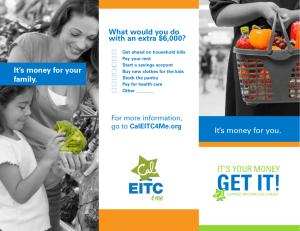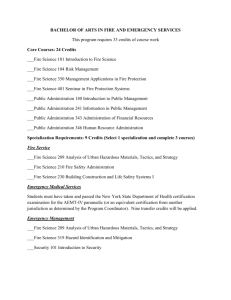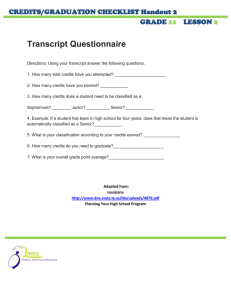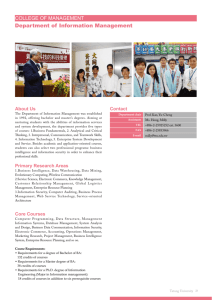Start with the End in Mind: Building to Student Success Guided Pathways
advertisement
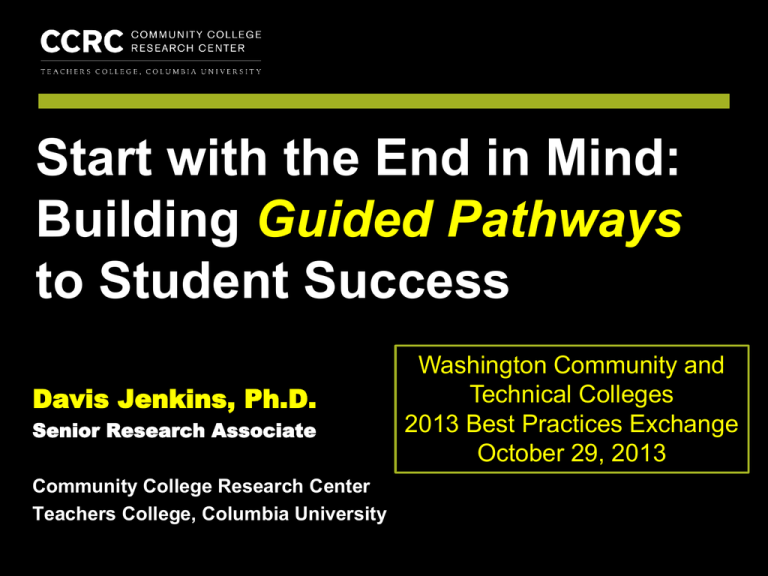
COMMUNITY COLLEGE RESEARCH CENTER Start with the End in Mind: Building Guided Pathways to Student Success Davis Jenkins, Ph.D. Senior Research Associate Community College Research Center Teachers College, Columbia University Washington Community and Technical Colleges 2013 Best Practices Exchange October 29, 2013 COMMUNITY COLLEGE RESEARCH CENTER Loss/Momentum Framework CONNECTION ENTRY PROGRESS COMPLETION From interest to application From entry to passing program gatekeeper courses From program entry to completion of program requirements Completion of credential of value for further education and labor market advancement Consider College Education Enter Program of Study Complete Program of Study COMMUNITY COLLEGE RESEARCH CENTER Pathway Analysis Questions CONNECTION ENTRY PROGRESS COMPLETION From interest to application From entry to passing program gatekeeper courses From program entry to completion of program requirements Completion of credential of value for further education and labor market advancement • How do we increase the number of new students who are motivated and prepared to enter a collegelevel program of study? • How do we increase the rates at which new students choose and successfully enter a program? • How do we accelerate rate at which students complete their program requirements? • How do we ensure our programs prepare students for further education and career advancement? COMMUNITY COLLEGE RESEARCH CENTER Student Completion Metrics 5-Year Highest Outcomes by Enrollment Status FTIC "Credit" Students 100% 90% Not Enrolled, No Outcome 80% 70% Still Enrolled with 30+ College Credits 60% Transfer 4-Year without Award Bachelor's from 4-Yr 50% Transfer 4-Year with Award 40% Associate 30% Certificate 20% 10% 0% Full-Time Part-Time COMMUNITY COLLEGE RESEARCH CENTER Connection/Entry: Findings • Many students drop out after 1-2 terms • Many students undecided • Many defaulted into “general education” • Students’ program progress not tracked • “Concentrators” more likely to complete • Math & English 101 not only “gatekeepers” COMMUNITY COLLEGE RESEARCH CENTER Entry/Connection: Majors LAS/Gen Studies Undeclared, 72% Protective, 6% Agriculture Auto & Aero 27 and Older Bus/Market Secretarial, 4% Secretarial LAS/Gen Studies, 10% Age Categories Comm/Design Undeclared, 48% Protective, 8% Comp Info Sic Culinary Eng/Arch 20 to 26 Eng/Sci Tech LAS/Gen Studies, 28% Education/childcare Secretarial, 4% Protective, 5% Allied Health Undeclared, 24% Nursing Construction Manufacturing 19 and Under Mechanics LAS/Gen Studies, 58% Secretarial, 1% Protective Undeclared 0% 10% 20% 30% 40% 50% 60% 70% 80% 90% 100% COMMUNITY COLLEGE RESEARCH CENTER Entry/Connection: Concentrators Five-Year Concentrator Rate by Declared “Major”: Full-time vs. Part-time Credit Students 100% 90% 80% 70% 60% Full-Time 50% Part-Time 40% 30% 20% 10% 0% LAS/General Studies Bus/Market Allied Health/Nursing Other CTE COMMUNITY COLLEGE RESEARCH CENTER Progress: Findings • Enrollment continuity may be as important as enrollment intensity • Students very confused by transfer process • Many students don’t follow recommended program curriculum • Low rate of gen ed core completion • Many students self-advising COMMUNITY COLLEGE RESEARCH CENTER Progress: Core Completion Gen Ed Core Credits Completed FTIC Students who Transferred Sample College 40% 35% 33% 30% 25% 20% 18% 17% 16% 15% 9% 10% 7% 5% 0% 0 credits 1-9 credits 10-19 credits 20-29 credits 30-41 credits Completed Core COMMUNITY COLLEGE RESEARCH CENTER 5-Year Outcomes by Gen Ed Core Credits Completed FTIC Students who Transferred, Sample College 100% 90% 80% Transferred to 4-year, no awards 70% Earned award at college, transferred to 4year, no BA 60% 50% Earned award at college, transferred, earned BA 40% No award at college, transferred, earned BA 30% 20% 10% 0% All Transfers (N=734) 0 core credits 1-9 core credits 10-19 core 20-29 core 30-41 core Completed credits credits credits core COMMUNITY COLLEGE RESEARCH CENTER Progress: Core Completion Earned More Gen Ed Core Credits than Required in Subject Area, All Transfer Students, Sample College 100% 90% 80% 70% 60% 50% 40% 30% 20% 10% 0% COMMUNITY COLLEGE RESEARCH CENTER Completion: Findings • Most students transfer without associate, despite research showing importance • Many graduates earn “excess” credits • Many students “linger” • Need to examine credential “stacking” patterns • Critical to track outcomes by program COMMUNITY COLLEGE RESEARCH CENTER Student Outcomes by Major 5-Year Highest Outcomes by Enrollment Status FTIC "Credit" Students 100% 90% Not Enrolled, No Outcome 80% 70% Still Enrolled with 30+ College Credits 60% Transfer 4-Year without Award Bachelor's from 4-Yr 50% Transfer 4-Year with Award 40% 30% Associate 20% Certificate 10% 0% LAS Business Allied Health/Nursing Other CTE COMMUNITY COLLEGE RESEARCH CENTER Transfer Student Outcomes Probability of Earning Bachelor’s in 6 Years Bachelor’s Completion by Credits Earned Source: Crosta & Kopko 2013 COMMUNITY COLLEGE RESEARCH CENTER Transfer Student Timing Proportion of Transfer Students by Number of College-Level Credits Completed Source: Crosta & Kopko 2013 COMMUNITY COLLEGE RESEARCH CENTER Community College Net Benefits Net Benefits of Community College by Outcome – Transfer Students: Earnings minus Total Cost (Undiscounted 2010 dollars; 20-year window) $120,000 $100,000 $80,000 $60,000 $40,000 $20,000 $1 2 3 4 5 6 7 8 9 10 11 12 13 14 15 16 17 18 19 20 $(20,000) $(40,000) $(60,000) AA_trans_BA AA_trans_noBA NoAA_trans_BA NoAA_trans_noBA Source: Belfield, 2013 COMMUNITY COLLEGE RESEARCH CENTER Transfer Destinations 2005-06 FTIC 5-Year Transfer Destinations Other 22% Public University 4 2% Private University 3 3% Public Unviersity 1 41% Public University 3 4% Private University 2 4% For-Profit Univ. 1 5% Public University 2 19% COMMUNITY COLLEGE RESEARCH CENTER Transfer Destination Grad Rates 2005-06 FTIC "Credit" Students' 5-Year Transfer Destinations Share of Transfers and Graduates Share of Transfers Share of Grads Public University 1 30.7% 39.8% Public University 2 7.5% 11.1% For-Profit University 1 6.8% 0.3% Public University 3 4.1% 7.0% Private University 1 3.7% 3.2% For-Profit University 1 3.0% 0.0% Public University 4 2.7% 2.0% COMMUNITY COLLEGE RESEARCH CENTER Transfer Bachelor’s Earners 2005-06 FTIC "Credit" Bachelor's Earners by Award Type Other, 15% B.S. in Nursing, 2% B.F.A., 3% B.S. in Bus. Admin., 8% B.A., 39% B.S., 33% COMMUNITY COLLEGE RESEARCH CENTER Transfer Bachelor’s Majors 2005-06 FTIC "Credit" Bachelor's Earners by Program Psychology, 8% Business Administration, 6% Communication Studies, 6% Elementary Education, 5% Other, 49% Biology, 5% Management, 5% Nursing, 5% Marketing, 4% Finance, 4% English, 5% COMMUNITY COLLEGE RESEARCH CENTER Credential “Stacking” by FTIC Community College Cohort Over 5 Years Of students who earned: …Percentage who also earned: Certificate Certificate ≥ Associate < 1 yr. 1 yr. degree Certificate < 1 yr. 7% Transfer to 4- Bachelor's year degree 22% 5% 1% 14% 3% 0% 36% 9% Certificate ≥ 1 yr. 11% Associate Degree 5% 2% Transfer to 4-yr. 0% 0% 13% Bachelor's Degree 0% 0% 17% 20% 100% COMMUNITY COLLEGE RESEARCH CENTER Status Quo Pathway Design • Little upfront career or college planning • Remediation narrowly focused on math and English, little “soft skills” prep • Programs paths unclear; too many choices • Poor alignment with requirements for further education and career advancement • Students’ progress not monitored • Limited on-going feedback and support COMMUNITY COLLEGE RESEARCH CENTER General Education Core ENGL 101 Dev Reading Intake Dev ENGL Allied Health Nursing Career-Path Career-Path Employment Employment A.S. Pre-major Business Electives A.A. Electives Transfer as Junior in Major Health Prereqs A.A.S. Certificates Math 101 ABE, ESL, GED Dev Math Meet with Advisor (1st Term Schedule) Voluntary Orientation Strong connection - Placement Testing Weak connection - COMMUNITY COLLEGE RESEARCH CENTER Guided Pathways to Success Clear roadmaps to success On-ramps to programs of study Progress tracking, feedback and support Bridges to college (from high school, adult basic skills, non-credit workforce programs) Collaborative communities of practice COMMUNITY COLLEGE RESEARCH CENTER Model Implementation at Scale • Florida State U (Exploratory majors) • Georgia State U (Structured Interventions) • Arizona State U (TAGs) • Austin Peay University (Degree Compass) • Valencia CC (Lifemap + Pre-majors) • Queensborough CC (Freshmen Academies) • Miami Dade (Communities of Interest) COMMUNITY COLLEGE RESEARCH CENTER First-Year Experience Education, Child Care Social Services Health Sciences Career-Path Career-Path Employment Employment Business STEM Social/Behavioral Science English, Arts, Humanities Transfer as Junior in Major A.A.S. Certificates Program On-Ramp Program On-Ramp Program On-Ramp Program On-Ramp Program On-Ramp Program On-Ramp Contextualized Basic Skills (e.g. I-BEST) Meet with Advisor (Choose initial program stream; plan full program schedule) Required Career Interest and Academic Readiness Testing Strong connection - Required Initial Orientation Weak connection - COMMUNITY COLLEGE RESEARCH CENTER Supporting Evidence • Highly varied student enrollment patterns • Students say they want guidance • Experimental evidence re: “nudges,” “defaults,” “active choice” • K-12 research on “instructional program coherence” and “constrained curricula” • Higher education research on “structure,” “contextualization” and “acceleration” COMMUNITY COLLEGE RESEARCH CENTER Pathway Redesign Principles 1) Give each student a clear roadmap to success 2) Ensure maps lead to further education and career advancment 3) Simplify choices for students 4) Monitor student progress, providing frequent feedback and support as needed 5) Engage faculty and staff across silos to map pathways and design integrated supports COMMUNITY COLLEGE RESEARCH CENTER Start with the End in Mind STEP 4 STEP 3 STEP 2 START HERE CONNECTION ENTRY PROGRESS COMPLETION From interest to application From entry to passing program gatekeeper courses From program entry to completion of program requirements Completion of credential of value for further education and labor market advancement • Market program paths • Build bridges from high school and adult ed. into program streams (e.g., strategic dual enrollment, I-BEST) • Help students choose program pathway and track entry • Build prescribed “on-ramps” customized to largest program streams • Clearly define and prescribe program paths • Monitor students’ progress and provide feedback and supports JIT • Incentivize progress • Align academic program outcomes with requirements for success in further education and (for CTE programs) in the labor market COMMUNITY COLLEGE RESEARCH CENTER PRESENTATION TITLE IN HEADER / MONTH XX, 2012 COMMUNITY COLLEGE RESEARCH CENTER Stakeholder Engagement Challenges Solutions Leadership Buy-in Get on the Same Page Lack of Authenticity Purposeful Engagement Initiative Overload Fundamental Restructuring, Tie to Mission Resistance to Mandates Collaborative Redesign Heavy Workloads Respect & Recognition Fear of Change Honesty & Clarity Poorly Structured Meetings Quality Facilitation, Goal & Role Clarity Source: Public Agenda 2013 COMMUNITY COLLEGE RESEARCH CENTER For more information Please visit us on the web at http://ccrc.tc.columbia.edu where you can download presentations, reports, and briefs, and sign-up for news announcements. We’re also on Facebook and Twitter. Community College Research Center Institute on Education and the Economy, Teachers College, Columbia University 525 West 120th Street, Box 174, New York, NY 10027 E-mail: ccrc@columbia.edu Telephone: 212.678.3091 COMMUNITY COLLEGE RESEARCH CENTER Ideal CC Student Pathways Source: Crosta 2013. COMMUNITY COLLEGE RESEARCH CENTER Actual CC Student Pathways N=14,429. Source: Crosta 2013. COMMUNITY COLLEGE RESEARCH CENTER Actual CC Student Pathways N=14,429. Source: Crosta 2013.

